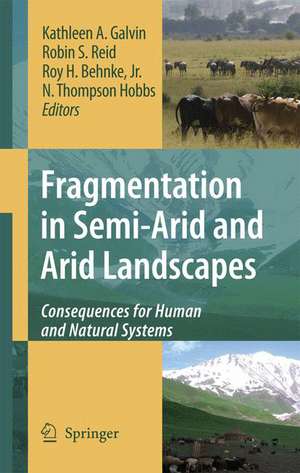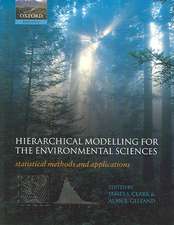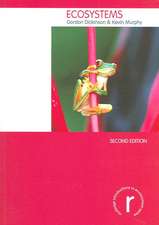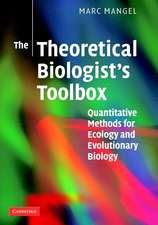Fragmentation in Semi-Arid and Arid Landscapes: Consequences for Human and Natural Systems
Editat de Kathleen A. Galvin, Robin S. Reid, Roy H. Behnke, Jr., N. Thompson Hobbsen Limba Engleză Hardback – 26 oct 2007
| Toate formatele și edițiile | Preț | Express |
|---|---|---|
| Paperback (1) | 951.14 lei 6-8 săpt. | |
| SPRINGER NETHERLANDS – 19 oct 2010 | 951.14 lei 6-8 săpt. | |
| Hardback (1) | 957.32 lei 6-8 săpt. | |
| SPRINGER NETHERLANDS – 26 oct 2007 | 957.32 lei 6-8 săpt. |
Preț: 957.32 lei
Preț vechi: 1167.45 lei
-18% Nou
Puncte Express: 1436
Preț estimativ în valută:
183.22€ • 190.77$ • 154.84£
183.22€ • 190.77$ • 154.84£
Carte tipărită la comandă
Livrare economică 10-24 martie
Preluare comenzi: 021 569.72.76
Specificații
ISBN-13: 9781402049057
ISBN-10: 1402049056
Pagini: 428
Ilustrații: XVII, 411 p.
Dimensiuni: 155 x 235 x 24 mm
Greutate: 0.79 kg
Ediția:2008
Editura: SPRINGER NETHERLANDS
Colecția Springer
Locul publicării:Dordrecht, Netherlands
ISBN-10: 1402049056
Pagini: 428
Ilustrații: XVII, 411 p.
Dimensiuni: 155 x 235 x 24 mm
Greutate: 0.79 kg
Ediția:2008
Editura: SPRINGER NETHERLANDS
Colecția Springer
Locul publicării:Dordrecht, Netherlands
Public țintă
Professional/practitionerCuprins
and Framework.- Global Significance of Extensive Grazing Lands and Pastoral Societies: An Introduction.- Fragmentation of Arid and Semi-Arid Ecosystems: Implications for People and Animals.- Causes and Consequences of Herbivore Movement in Landscape Ecosystems.- Case Studies.- Changing Patterns of Land Use and Tenure in the Dalrymple Shire, Australia.- From Fragmentation to Reaggregation of Rangelands in the Northern Great Plains, USA.- Land Use, Fragmentation, and Impacts on Wildlife in Jackson Valley, Wyoming, USA.- Ideology, Land Tenure and Livestock Mobility in Kazakhstan.- Policy Changes in Mongolia: Implications for Land Use and Landscapes.- Fragmentation of a Peri-Urban Savanna, Athi-Kaputiei Plains, Kenya.- Processes of Fragmentation in the Amboseli Ecosystem, Southern Kajiado District, Kenya.- Ngorongoro Conservation Area, Tanzania: Fragmentation of a Unique Region of the Greater Serengeti Ecosystem.- North-West Province, South Africa: Communal and Commercial Livestock Systems in Transition.- Issues Of Fragmentation And Complexity: A Synthetic Perspective.- The Drivers of Fragmentation in Arid and Semi-Arid Landscapes.- Comparing Landscape and Infrastructural Heterogeneity within and between Ecosystems.- Responses of Pastoralists to Land Fragmentation: Social Capital, Connectivity and Resilience.
Textul de pe ultima copertă
Exploring the concept of fragmentation, the ecological processes interrupted by fragmentation, and the social consequences of fragmented landscapes, this book presents a timely synthesis on the effects of fragmentation on arid and semi-arid pastoral systems throughout the world.
The global significance of the world’s rangelands is large, with these arid and semi-arid systems making up almost 25% of the earth’s landscapes – and supporting the livelihoods of more than 20 million people. These ecosystems are also home to several of the planet’s remaining megafauna, as well as other important species. Yet fragmentation across these rangelands has significantly impaired the ability of both people and animals to compensate for temporal heterogeneity in vegetation and water by exploiting its spatial heterogeneity, resulting in limited resource availability.
The case is developed that while fragmentation arises from different natural, social and economic conditions worldwide it creates similar outcomes for human and natural systems. With information from nine sites around the world the authors examine how fragmentation occurs, the patterns that result, and the consequences of fragmentation for ecosystems and the people who depend on them. The book will provide a valuable reference for students and researchers in rangeland ecology, park and natural resource management, environmental and ecological anthropology, economics and agriculture.
The global significance of the world’s rangelands is large, with these arid and semi-arid systems making up almost 25% of the earth’s landscapes – and supporting the livelihoods of more than 20 million people. These ecosystems are also home to several of the planet’s remaining megafauna, as well as other important species. Yet fragmentation across these rangelands has significantly impaired the ability of both people and animals to compensate for temporal heterogeneity in vegetation and water by exploiting its spatial heterogeneity, resulting in limited resource availability.
The case is developed that while fragmentation arises from different natural, social and economic conditions worldwide it creates similar outcomes for human and natural systems. With information from nine sites around the world the authors examine how fragmentation occurs, the patterns that result, and the consequences of fragmentation for ecosystems and the people who depend on them. The book will provide a valuable reference for students and researchers in rangeland ecology, park and natural resource management, environmental and ecological anthropology, economics and agriculture.
Caracteristici
First book to show how fragmentation of natural systems influences human welfare, economies Unique in global coverage, integration of social, natural sciences of fragmentation in rangelands Complex systems are self sustaining, whereas simplified ones often want capital inputs, subsidies Shows linkage of multiple scale analyses Rangeland use exclusivity does not promote human welfare or sustain natural processes














